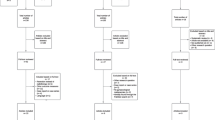Abstract
Background
Pelvic radiation therapy is an important element of curative therapy for gynaecological cancers. Serious radiation-related complications developing months or years after treatment are known as late radiation tissue injury (LRTI).
Methods
We investigated the possible pain reducing effect of hyperbaric oxygen treatment (HBOT) in a study of 16 patients with LRTI after radiation for gynaecological malignancy. The 16 patients were registered prospectively, underwent HBOT for 21 consecutive days and were followed for a 6-month period after treatment using the Brief Pain Inventory, Montgomery and Aasberg Depression Rating Scale, as well as registration of global patient scores, analgesic consumption and magnetic resonance imaging (MRI) findings.
Results
HBOT was shown to have insignificant effect on pain, pain characteristics, daily function, the use of analgesics and MRI-related tissue injury. Fifty percent of the patients still reported some or good effect of the treatment.
Conclusion
It is not possible to conclude from our study if gynaecological patients with pelvic pain will benefit from HBOT. The application of HBOT to selected patients may be justified, but further research with adequate sample size, as well as the timing of HBOT related to the development of LRTI, is required to establish the optimum patient selection.

Similar content being viewed by others
References
Rubin P, Casarrett GW (1968) Clinical Radiation Pathology. Vol. 1. Saunders, Philadelphia, pp 58–61
Stone HB, Coleman CN, Anscher MS, McBride WH (2003) Effetcs of radiation on normal tissues: consequences and mechanisms. Lancet Oncol 4(9):711–728. doi:10.1016/S1470-2045(03)01191-4
Thompson IM, Middleton RG, Optenberg SA, Austenfeld MS, Smalley SR, Cooner WH, Correa RJ, Miller HC Jr, Oesterling JE, Resnick MI, Wasson JH, Cg R (1999) Have compliacation rates decreased after treatment for localized prostate cancer? J Urol 162(1):107–112. doi:10.1097/00005392-199907000-00026
Waddell BE, Rodriguez-Bigas MA, Lee RJ, Weber TK, Petrelli NJ (1999) Prevention of chronic radiation enteritis. J Am Coll Surg 189(6):611–624. doi:10.1016/S1072-7515(99)00199-4
Cleeland CS (1985) Measurement and prevalence of pain in cancer. Semin Oncol Nurs 1(2):87–92. doi:10.1016/S0749-2081(85) 80041-3
Klepstad P, Loge JH, Borchgrevink PC et al (2002) The Norwegian brief pain inventory questionnaire: translation and validation in cancer pain patients. J Pain Symptom Manage 24(5):517–525. doi:10.1016/S0885-3924(02)00526-2
Montgomery SA, Aasberg M (1979) A new depression scale designed to be sensitive to change. Br J Psychiatry 134:382–389
Gray LH, Conger AD, Ebert M, Hornsey S, Scott OC (1953) The concentration of oxygen dissolved in tissues at the time of irradiation as a factor in radiotherapy. Br J Radiol 26(312):638–648
Churchill-Davidson I, Sanger C, Thomlinson RH (1955) High-pressure oxygen and radiotherapy. Lancet 268(6874):1091–1095. doi:10.1016/S0140-6736(55)90589-4
Rubin P (1984) Late effects of chemotherapy and radiation therapy: a new hypothesis. Int J Radiat Oncol Biol Phys 10(1):5–34
Williamson RA (2007) An experimental study of the use of hyperbaric oxygen to reduce the side effects of radiation treatment for malignant disease. Int J Oral Maxillofac Surg 36(6):533–540. doi:10.1016/j.ijom.2007.03.003
Leach RM, Rees PJ, Wilmshurst P (1998) Hyperbaric oxygen therapy. BMJ 317(7166):1140–1143
Pasquier D, Hoelscher T, Schmutz J, Dische S, Mathieu D, Baumann M, Lartigau E (2004) Hyperbaric oxygen therapy in the treatment of radio-induced lesions in normal tissues: a literature review. Radiother Oncol 72(1):1–13. doi:10.1016/j.radonc.2004.04.005
Bennett MH, Feldmeier J, Hampson N, Smee R, Milross C (2005) Hyperbaric oxygen therapy for late radiation tissue injury. Cochrane Database Syst Rev 20(3):CD005005
Safra T, Gutman G, Fishlev G et al (2008) Improved quality of life with hyperbaric oxygen therapy in patients with persistent pelvic radiation. Clin Oncol 20(4):284–287. doi:10.1016/j.clon.2007.12.005
Bennet M, Feldmeier J, Smee R, Milross C (2008) Hyperbaric oxygenation for tumour sensitisation to radiotherapy: A systemtic review of randomised controlled trials. Cancer Treat Rev 34(7):577–591. doi:10.1016/j.ctrv.2008.01.001
Wang P, Yuan C, Lai C, Chao H, Tseng J, Chiang H, Lee W, Lee S, Ng H (1999) Rapid progression of squamous cell carcinoma of the cervix after hyperbaric oxygenation. Eur J Obstet Gynecol Reprod Biol 82(1):89–91. doi:10.1016/S0301-2115(98)00168-7
Feldmeier JJ, Heimbach RD, Davolt DA, Mj B, Sheffield PJ, Porter AT (1994) Does hyperbaric oxygen have a cancer-causing or–promoting effect? A review of pertinent literature. Undersea Hyperb Med 21(4):467–475
Blomlie V, Rofstad EK, Talle K, Sundfør K, Winderen M, Lien HH (1996) Incidence of radiation-induced insufficiency fractures of the female pelvis: evaluation with MR imaging. AJR Am J Roentgenol 167(5):1205–1210
Author information
Authors and Affiliations
Corresponding author
Rights and permissions
About this article
Cite this article
Rud, A.K., Bjørgo, S., Kristensen, G.B. et al. Hyperbaric oxygen therapy for late radiation tissue injury in gynaecological patients. Support Care Cancer 17, 1517–1521 (2009). https://doi.org/10.1007/s00520-009-0619-1
Received:
Accepted:
Published:
Issue Date:
DOI: https://doi.org/10.1007/s00520-009-0619-1



